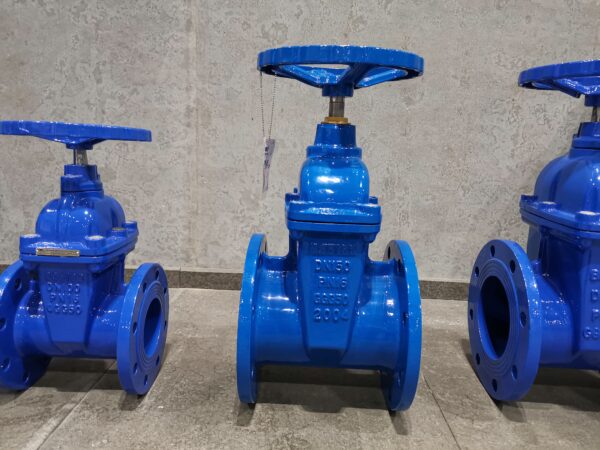The use of underground gate valves is typically governed by industry standards and specifications to ensure their proper design, construction, and performance in specific applications. These standards provide guidelines for materials, dimensions, testing, and other requirements.
Some of the commonly referenced standards for underground gate valves include:
- AWWA C509 – Resilient-Seated Gate Valves for Water Supply Service:
- Published by the American Water Works Association (AWWA), AWWA C509 is a standard that covers resilient-seated gate valves for use in water supply service. It provides specifications for materials, design, testing, and performance requirements. This standard is widely adopted for underground gate valves used in water distribution systems.
- AWWA C515 – Reduced Wall, Resilient-Seated Gate Valves for Water Supply Service:
- Another AWWA standard, C515, addresses reduced wall, resilient-seated gate valves used in water supply service. It provides specifications for materials, design, testing, and performance requirements for this specific type of gate valve.
- AWWA C504 – Rubber-Seated Butterfly Valves:
- While AWWA C504 specifically addresses rubber-seated butterfly valves, it is relevant for underground applications where butterfly valves are used. The standard covers materials, design, testing, and performance criteria for rubber-seated butterfly valves in waterworks applications.
- BS EN 1074-2 – Valves for Water Supply – Fitness for Purpose Requirements:
- This European standard, part of the BS EN 1074 series, provides requirements for the fitness for purpose of valves used in water supply applications. It covers various types of valves, including gate valves, and includes considerations for materials, design, and testing.
- ISO 7259 – Water supply – Valve assemblies for buried or submerged pipelines – General requirements and test methods:
- ISO 7259 is an international standard that provides general requirements and test methods for valve assemblies used in buried or submerged pipelines for water supply. It includes specifications for materials, design, and testing of valves suitable for underground applications.
- AWWA M11 – Steel Water Pipe: A Guide for Design and Installation:
- While not specific to gate valves, AWWA M11 provides guidance on the design and installation of steel water pipe systems, including considerations for valves. It can be a valuable resource for understanding best practices in water infrastructure.
It’s important to note that local regulations and specifications may also influence the use of underground gate valves. Municipalities and water authorities may have additional requirements or standards that must be followed to ensure compliance with local codes.
When selecting and installing underground gate valves, it is crucial to consult the relevant standards and specifications, as well as local regulations, to ensure that the valves meet the necessary performance and safety requirements for their intended application. underground gate valve Manufacturers and suppliers of underground gate valves often provide documentation and certifications to confirm compliance with applicable standards.
What are the specific mechanical properties of underground gate valve material?
The mechanical properties of the material used in underground gate valves are crucial for ensuring the valve’s performance and durability in various operating conditions. The specific mechanical properties can vary based on the material chosen for the valve construction. Common materials for underground gate valves include ductile iron, cast iron, stainless steel, and other alloys.
Here are some key mechanical properties and considerations for these materials:
- Ductile Iron:
- Tensile Strength: Typically ranges from 60,000 to 100,000 psi.
- Yield Strength: Generally around 40,000 to 70,000 psi.
- Elongation: Typically 10% or more.
- Hardness: Measured on the Brinell scale, typically ranging from 170 to 240 HB.
- Cast Iron:
- Tensile Strength: Generally in the range of 20,000 to 60,000 psi.
- Yield Strength: Varies but is generally lower than tensile strength.
- Elongation: Lower compared to ductile iron.
- Hardness: Measured on the Brinell scale, typically ranging from 180 to 240 HB.
- Stainless Steel (e.g., CF8, CF8M):
- Tensile Strength: Varies based on the specific alloy, but can range from 70,000 to 100,000 psi or higher.
- Yield Strength: Typically around 30,000 to 60,000 psi.
- Elongation: Varies based on the alloy, but can be 20% or more.
- Hardness: Measured on the Rockwell scale (typically Rockwell B or Rockwell C), can range from 75 to 90 HRB or 15 to 30 HRC.
- Alloy Steels (e.g., Chrome-Molybdenum Alloys):
- Tensile Strength: Higher than carbon steel, often exceeding 100,000 psi.
- Yield Strength: Generally higher than carbon steel.
- Elongation: Varies based on the specific alloy.
- Hardness: Depends on the alloy, but can be relatively high.
These mechanical properties provide an indication of the material’s strength, ductility, and hardness. The choice of material depends on factors such as the operating conditions (including pressure and temperature), the nature of the fluid being handled, and considerations for corrosion resistance. For example, ductile iron is often preferred for its combination of strength and ductility, while stainless steel is chosen for its corrosion resistance.
It’s important to note that the mechanical properties of a specific underground gate valve material are typically specified by the manufacturer and may be subject to industry standards such as AWWA (American Water Works Association), ISO (International Organization for Standardization), or other relevant standards. Valve manufacturers provide detailed documentation, including material specifications and test reports, to assist in the selection and verification of suitable materials for specific applications. Consulting with the manufacturer and referring to applicable standards are essential steps in ensuring that the mechanical properties meet the requirements of the intended use.
